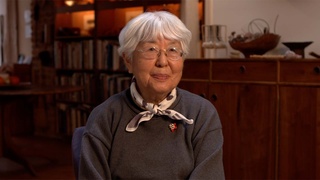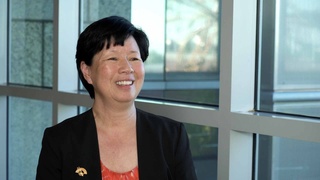Interviews
Marriage and Returning to US
In 1948, we were married in a little Methodist Church on the Ginza—just her father, Shizuko Naito, and I guess her father's friends or...there were only a small group of us at the wedding.
And nineteen...we lived in Fujisawa, I worked at NYK building in Tokyo and took the train everyday—commuted—from Fujisawa because her father gave us a room for ourself, which extended to the Japanese garden, it was a beautiful place and had a big pool with Japanese carp and beautiful goldfish and in 1950 I finally got permission to take my wife back to the U.S.
At that time, there were no Orientals allowed, in 1950, in America. So my father went to an alderman, greased his palm—for his connections in Washington—and there they passed a bill, I forget the name of it—the number, 7276 or something like that, that allowed her to come into the United States. And so in 1950, November, we left on the General Mann, it was a transport ship—army transport—and there was a storm just outside of Yokohama—again—in the winter, of course, and it followed us all the way to San Francisco, where we docked. And then we got on a train, and Hamako was very sea-sick and miserable, and we went to Solano Beach, where my aunt had my father buy a small place, so we would have a place to live.
Date: January 26, 2012
Location: California, US
Interviewer: John Esaki, Yoko Nishimura
Contributed by: Watase Media Arts Center, Japanese American National Museum
Explore More Videos

Being inducted into the army
(b. 1921) Nisei veteran who served in the occupation of Japan

Serving in Tokyo
(b. 1921) Nisei veteran who served in the occupation of Japan

The Dopey bank that survived the war
(b. 1934) Award-winning Disney animation artist who was incarcerated at Topaz during WWII

Evacuated to the Jungle
(b. 1938) Philipines-born hikiagesha who later migrated to the United States.

Captured by Guerillas after bombing of Pearl Harbor
(b. 1938) Philipines-born hikiagesha who later migrated to the United States.

Grandfather picked up by US Army
(b. 1952) Former banking executive, born in Hawaii

Father's business partner operated their farming business during WWII
(b. 1935) Sansei businessman.

Father was convinced the constitution would protect him
(b. 1935) Sansei businessman.

The lack of discussion about family’s incarceration in Amache
Sansei judge for the Superior Court of Los Angeles County in California


Her brother’s reasons as a No-No Boy
(b. 1923) Japanese American poet, activist

Her grandfather was pressured to teach Japanese
Sansei judge on the Superior Court of Los Angeles County in California

Neighbor took care of her mother after grandfather was taken by FBI
Sansei judge on the Superior Court of Los Angeles County in California

Immediately after the bombing
(b. 1938) Japanese American. Hiroshima atomic bomb survivor

Other family members not as lucky
(b. 1938) Japanese American. Hiroshima atomic bomb survivor
